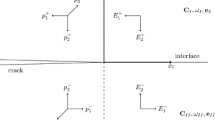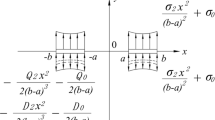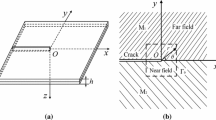Abstract
A singular integral equation method is proposed to analyze the two-dimensional (2D) multiple cracks in anisotropic piezoelectric bimaterial. Using the Somigliana formula, a set of singular integral equations for the multiple crack problems are derived, in which the unknown functions are the derivatives of the generalized displacement discontinuities of the crack surfaces. Then, the exact analytical solution of the extended singular stresses and extended stress intensity factors near the crack tip is obtained. Singular integrals of the singular integral equations are computed by the Gauss–Chebyshev collocation method. Finally, numerical solutions of the extended stress intensity factors of some examples are presented and discussed.










Similar content being viewed by others
References
Meitzler AH, Sittig EK. Characterization of piezoelectric transducers used in ultrasonic devices operating above 0.1 GHz. J Appl Phys. 1969;40(11):4341–52.
Kudriavtsev BA, Parton VZ, Rakitin VI. Fracture mechanics of piezoelectric materials. Rectilinear tunnel crack on the boundary with a conductor. J Appl Math Mech. 1975;39(1):136–46.
Williams ML. The stresses around a fault or crack in dissimilar media. Bull Seismol Soc Am. 1959;49(2):199–204.
Erdogan F, Gupta GD. Layered composites with an interface flaw. Int J Solids Struct. 1971;7(8):1089–107.
Erdogan F. Mixed boundary value problems in mechanics. Bethlehem: Lehigh University; 1975.
Beom HG, Atluri SN. Near-tip fields and intensity factors for interfacial cracks in dissimilar anisotropic piezoelectric media. Int J Fract. 1996;75(2):163–83.
Herrmann KP, Loboda VV, Govorukha VB. On contact zone models for an electrically impermeable interface crack in a piezoelectric bimaterial. Int J Fract. 2001;111(3):203–27.
Ou ZC, Wu X. On the crack-tip stress singularity of interfacial cracks in transversely isotropic piezoelectric bimaterials. Int J Solids Struct. 2003;40(26):7499–511.
Shen S, Nishioka T, Hu SL. Crack propagation along the interface of piezoelectric bimaterial. Theoret Appl Fract Mech. 2000;34(3):185–203.
Tian WY, Chen YH. Interaction between an interface crack and subinterface microcracks in metal- piezoelectric bimaterials. Int J Solids Struct. 2000;37(52):7743–57.
Fang QH, Feng H, Liu YW. Electroelastic interaction between a piezoelectric screw dislocation and a circularly layered inclusion with imperfect interfaces. Appl Math Mech. 2013;34(1):49–62 (in Chinese).
Ting TCT, Hoang PH. Singularities at the tip of a crack normal to the interface of an anisotropic layered composite. Int J Solids Struct. 1984;20(5):439–54.
Li XF, Wang BL. Anti-plane shear crack normal to and terminating at the interface of two bonded piezoelectric ceramics. Int J Solids Struct. 2007;44(11):3796–810.
Tang RJ, Qin TY. Method of hypersingular integral equations in three-dimensional fracture mechanics. Acta Mech Sin. 1993;25:665–75.
Zhu BJ, Qin TY. Hypersingular integral equation method for a three-dimensional crack in anisotropic electro-magneto-elastic bimaterials. Theoret Appl Fract Mech. 2007;47(3):219–32.
Tian W, Chau KT. Arbitrarily oriented crack near interface in piezoelectric bimaterials. Int J Solids Struct. 2003;40(8):1943–58.
Yang PS, Liou JY, Sung JC. Subinterface crack in an anisotropic piezoelectric bimaterial. Int J Solids Struct. 2008;45(18):4990–5014.
Fan CY, Zhou YH, Wang H, Zhao MH. Singular behaviors of interfacial cracks in 2D magnetoelectroelastic bimaterials. Acta Mech Solida Sin. 2009;22(3):232–9.
Sharma K, Bui TQ, Zhang C, et al. Analysis of a subinterface crack in piezoelectric bimaterials with the extended finite element method. Eng Fract Mech. 2013;104:114–39.
Ma P, Su RKL, Feng WJ, Li YS. The extended finite element method with new crack-tip enrichment functions for an interface crack between two dissimilar piezoelectric materials. Int J Numer Meth Eng. 2015;103(2):94–113.
Ma P, Su RKL, Feng WJ. Moving crack with a contact zone at interface of magnetoelectroelastic bimaterial. Eng Fract Mech. 2017;181:143–60.
Ueda S, Okada M, Nakaue Y. Transient thermal response of a functionally graded piezoelectric laminate with a crack normal to the bimaterial interface. J Therm Stresses. 2018;41(1):98–118.
Mabuchi Y, Ueda S. Transient thermal response of functionally graded piezoelectric laminates with an infinite row of parallel cracks normal to the bimaterial interface. Theor Appl Mech Lett. 2019;9(5):289–92.
Pan E. A BEM analysis of fracture mechanics in 2D anisotropic piezoelectric solids. Eng Anal Bound Elem. 1999;23(1):67–76.
Chung MY, Ting TCT. Line force, charge, and dislocation in anisotropic piezoelectric composite wedges and spaces. J Appl Mech. 1995;62(2):423–8.
Acknowledgements
The authors would like to express their special thanks to the National Natural Science Foundation of China (Project No. 11172320).
Author information
Authors and Affiliations
Corresponding author
Rights and permissions
About this article
Cite this article
Cao, T., Feng, X. & Qin, T. Analysis for Multiple Cracks in 2D Piezoelectric Bimaterial Using the Singular Integral Equation Method. Acta Mech. Solida Sin. 35, 261–272 (2022). https://doi.org/10.1007/s10338-021-00281-5
Received:
Revised:
Accepted:
Published:
Issue Date:
DOI: https://doi.org/10.1007/s10338-021-00281-5




